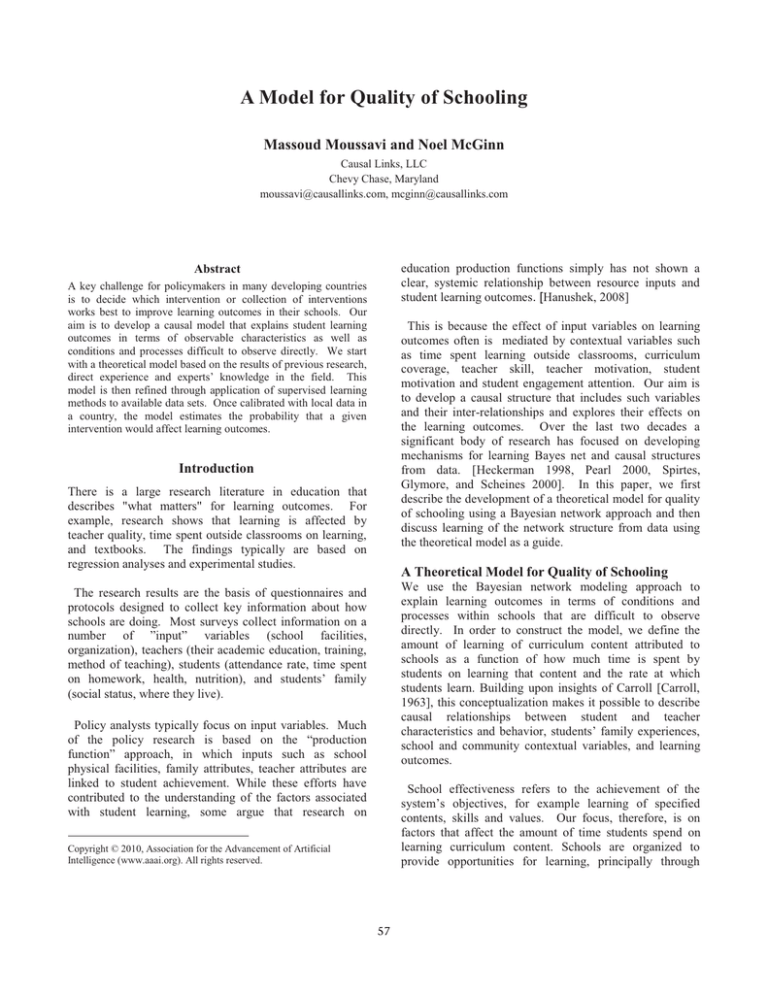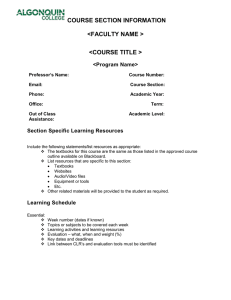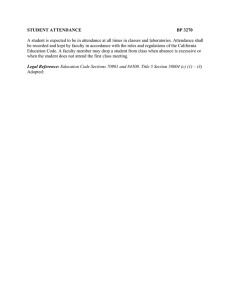
A Model for Quality of Schooling
Massoud Moussavi and Noel McGinn
Causal Links, LLC
Chevy Chase, Maryland
moussavi@causallinks.com, mcginn@causallinks.com
education production functions simply has not shown a
clear, systemic relationship between resource inputs and
student learning outcomes. [Hanushek, 2008]
Abstract
A key challenge for policymakers in many developing countries
is to decide which intervention or collection of interventions
works best to improve learning outcomes in their schools. Our
aim is to develop a causal model that explains student learning
outcomes in terms of observable characteristics as well as
conditions and processes difficult to observe directly. We start
with a theoretical model based on the results of previous research,
direct experience and experts’ knowledge in the field. This
model is then refined through application of supervised learning
methods to available data sets. Once calibrated with local data in
a country, the model estimates the probability that a given
intervention would affect learning outcomes.
This is because the effect of input variables on learning
outcomes often is mediated by contextual variables such
as time spent learning outside classrooms, curriculum
coverage, teacher skill, teacher motivation, student
motivation and student engagement attention. Our aim is
to develop a causal structure that includes such variables
and their inter-relationships and explores their effects on
the learning outcomes. Over the last two decades a
significant body of research has focused on developing
mechanisms for learning Bayes net and causal structures
from data. [Heckerman 1998, Pearl 2000, Spirtes,
Glymore, and Scheines 2000]. In this paper, we first
describe the development of a theoretical model for quality
of schooling using a Bayesian network approach and then
discuss learning of the network structure from data using
the theoretical model as a guide.
Introduction
There is a large research literature in education that
describes "what matters" for learning outcomes. For
example, research shows that learning is affected by
teacher quality, time spent outside classrooms on learning,
and textbooks. The findings typically are based on
regression analyses and experimental studies.
A Theoretical Model for Quality of Schooling
We use the Bayesian network modeling approach to
explain learning outcomes in terms of conditions and
processes within schools that are difficult to observe
directly. In order to construct the model, we define the
amount of learning of curriculum content attributed to
schools as a function of how much time is spent by
students on learning that content and the rate at which
students learn. Building upon insights of Carroll [Carroll,
1963], this conceptualization makes it possible to describe
causal relationships between student and teacher
characteristics and behavior, students’ family experiences,
school and community contextual variables, and learning
outcomes.
The research results are the basis of questionnaires and
protocols designed to collect key information about how
schools are doing. Most surveys collect information on a
number of ”input” variables (school facilities,
organization), teachers (their academic education, training,
method of teaching), students (attendance rate, time spent
on homework, health, nutrition), and students’ family
(social status, where they live).
Policy analysts typically focus on input variables. Much
of the policy research is based on the “production
function” approach, in which inputs such as school
physical facilities, family attributes, teacher attributes are
linked to student achievement. While these efforts have
contributed to the understanding of the factors associated
with student learning, some argue that research on
School effectiveness refers to the achievement of the
system’s objectives, for example learning of specified
contents, skills and values. Our focus, therefore, is on
factors that affect the amount of time students spend on
learning curriculum content. Schools are organized to
provide opportunities for learning, principally through
Copyright © 2010, Association for the Advancement of Artificial
Intelligence (www.aaai.org). All rights reserved.
57
Textbooks (available, not available), Instruction Time
(adequate, not adequate), etc.
teaching but also through self-instructional methods.
Students also can learn the curriculum outside schools,
through teaching provided by others and by selfinstruction.
We specified the conditional probabilities according to
experts’ opinion, the literature review, and in a few cases
based on automated learning from available data. We were
encouraged that our model did as well as a regression
model based on the same data set in predicting students’
pass/fail reading scores. As the data sets available for Peru
and Jamaica were small and very limited data was
available on many variables defined in the model, we could
not rely on automated learning of all the conditional
probabilities from data.
But the main purpose of our
project was to develop a model that reflects the existing
research in the field and demonstrates the impact of
various interventions, both on the observed variables such
as textbooks as well as on the hidden variables such as
learning outside school.
A partial conceptualization of our model is shown in
Figure 1. This network explains student learning in terms
of interactions among many state variables that represent
the state of affairs of the education system in a country.
The effect of input or observed variables (e.g., student
attendance, teacher attendance, class size, teaching
experience, family involve, etc.) on the student learning
outcome (which is measured by the output variable reading
score) is mediated by a number of hidden variables
(teacher skill, motivation to learn, engagement attention,
etc.)
Student
Homogeneity
Class
Size
Student
Attendance
Teacher
Attendance
TchgExpce
Teacher
Educ
Textbooks
Teacher
Skill
Classroom
Order
FamilySES
Motivation
To Learn
Instruction
Time
Family
Involve
Learning the Structure of the Model from Data
Acad
History
We have conducted a series of studies in learning the
Bayesian network structure directly from available data
sets using the Tetrad modeling tool [Scheines, et al., 1994].
As a start we have used data available from NELS 88
[National Center for Education Statistics, 2002] which is
based on information from 11,384 American 8 th grade
students. The dataset includes observations for all but the
following four variables shown in the theoretical model
shown in Figure 1: Teacher Skill, Learning outside School,
Learning in School, and Instruction Time.
Engagement
Attention
Learning
In School
Reading
Score
Learning
Outside School
Math
Score
Figure 1: A partial network structure
Hidden variables (variables difficult to observe and not
included in most available data) greatly reduce the number
of probability estimates required to specify the network.
But the main reason for introducing these variables is that
they explain the causal structure of our learning model. A
hidden variable such as Instruction Time is affected by
observable variables Teacher Attendance Student
Attendance, and Classroom Order but can also be affected
by other interventions . For example, instruction time can
be increased directly by hiring additional teachers or
lengthening class time. Clearly, no general model can
account for all possible interventions and include them as
observable variables.
We carried out a number of learning experiments both
unsupervised and supervised on this dataset. Again we
limited the variables to binary values. The example shown
here is based on a supervised learning taking advantage of
the “knowledge tiers” option provided in Tetrad. In this
example we specified the following tiers:
Tier 1: FamilySES, UrbanResidence, Teacher
Attendance, TchgExpce, TeacherEduc, Student
Homogeneity, ClassSize, Textbooks, AcadHist.
Tier 2: Family Involve, Student Attendance,
Engagement Attention, Motivation to Learn,
Classroom Order.
We applied the model in two case studies in Peru and
Jamaica sponsored by USAID [McGinn and Moussavi
2008] to predict the reading comprehension score for 2 nd
grade students and to determine which interventions have
the most impact on the outcome. The dataset used was
collected by another USAID project [Crouch, 2008] for
512 students from 64 schools in Peru and 384 students
from 48 schools in Jamaica. The model developed for
these countries consisted of more than 60 variables of
which only about one third were observed in the dataset.
We defined all variables as binary.
For example,
Tier 3: Read8 and Math8 (that is, the scores for
reading and math).
Variables in a tier cannot influence variables in tiers
above them. For example, variables in tier 3 cannot
influence any other variables. We also used the option of
forbidding links between variables in both tiers 1 and 3.
For example, FamilySES and Teacher Attendance within
tier 1 cannot influence each other.
58
Figure 2: A discovered network structure
The resulting network structure without any latent
variables is shown in Figure 2. How sensible is this result?
Tetrad’s discovery of the structure is based on the PC
algorithm and we have not yet applied other more recent
algorithms (e.g., the max-min hill climbing algorithm,
greedy equivalent search) to compare the effectiveness of
various algorithms. Nevertheless, it is encouraging to see
that this structure is mostly in agreement with our
theoretical model discussed earlier.
common cause for these variables. That variable could
indeed be Teacher Skill as defined in our theoretical model
and/or the instructional methods used by the teacher.
Finally, the presence of a link from UrbanResidence to
ClassRoomOrder seems dubious and not substantiated with
research in the field.
However, the link from
UrbanResidence to MotivationToLearn is a curious one.
While to our knowledge there is no research in this area, it
can be justified in the sense that schools’ curricula are
often more geared toward urban areas and thus more
applicable to students in urban areas.
A number of observations can be made on the discovered
structure.
For example, in this network structure
TeacherEduc and Textbooks seem to not matter for
learning outcomes. While research has been inconsistent
on the impact of teacher academic education on learning
outcomes, it has shown that textbooks do matter.
Irrelevance of textbooks in this data set can be explained
by a number of reasons: it is possible that teachers were
not using the textbooks; the contribution of textbooks to
learning may depend on how (and how well) teachers use
the books in their teaching; there may be another,
unspecified or latent variable that accounts for both
textbook use and learning outcomes; textbooks may vary in
quality and in content as there are four major textbook
publishers in the United States; and finally the impact of
textbooks may also be linked to student use outside the
classroom.
We plan to further analyze these possibilities with more
extensive datasets and variables and reconcile the
discovered structures with our theoretical model.
Conclusion
Many of the features of the teaching and learning process
are difficult to observe and not measured in large-sample
surveys of school operation and student learning. Most
current policy analysis relies on data that describes only
some of the material and human resource inputs to the
school and characteristics of students. These factors
interact in unspecified ways in the complex process of
instruction and learning, and are insufficient to explain
most of the variation in measures of learning outcomes.
This complexity is seen in our analysis of different data
sets. Schools achieve relatively equal levels of
effectiveness (average student test scores) with widely
differing levels of inputs and combinations of instructional
Another interesting observation is the presence of double
headed links between Motivation to Learn and
Engagement Attention and between Classroom Order and
Engagement Attention. This indicates the possibility of a
59
practices. Our model reflects at least some of the
complexity of teaching and learning.
Hanushek, E. A. (2008). Education production functions.
In The New Palgrave Dictionary of Economics.
A model of the kind we have presented can be used in
many ways. First, it can distinguish between learning
attributable to a school’s effectiveness, and that which is
explained by learning occurring outside the school.
Second, the model can be used to suggest different
strategies for improving learning, some that change inputs
and instructional practices in schools, others that change
the school’s relationship with families and the community.
Third, in cases where no reliable or standardized test scores
are available, the model can be used in a predictive fashion
to determine identify “failing schools.” Finally, the model
can be used as a practical tool for educating policymakers
and school administrators.
Heckerman, D. (1998). A tutorial on learning with
Bayesian networks. In Jordan, M. I. (Ed.), Learning in
graphical models. Kluwer, Dordrecht, Netherlands.
McGinn, N. and Moussavi, M. (2008). Summative Report
for USAID. www.causallinks.com.
National Center for Education Statistics (2002). National
Education Longitudinal Study: 1988-2000 data files and
electronic notebook system.
Washington, DC: U.S.
Department of Education.
Pearl, J. (2000). Causality: Models, Reasoning, and
Inference. Cambridge University Press, Cambridge, UK.
As for future work on the model, many challenging issues
remain. We would like to apply more recent, state of the
art algorithms to the same data set to discover the
underlying network structure and compare the results
against our current structure. Furthermore, we intend to
conduct the analysis for a larger number of variables. In
addition, we would need to validate the model and measure
its accuracy in predicting the test scores.
Scheines, R., Spirtes, P. Glymour, C., and Meek, C.
(1994). Tetrad II: User manual, Lawrence Erlbaum,
Hillsdale, New Jersey.
Spirtes, Glymore, and Scheines (2000). Causation,
Prediction, and Search, 2nd ed. New York, N.Y.: MIT
Press.
We also need to develop dynamic models. Education by
nature is a long term process and requires models that can
take advantage of time series data. In this regard, of
course, collection of data for the same schools over a
number of years and the quality of data sets are key
challenges. At present we have available, in addition to
NELS 88, data from the Education Longitudinal Study of
2002, which includes data on a large sample of students
over three time periods. The ELS data set includes a
similar set of contextual and process variables as NELS 88.
We are looking for other large data sets that include a
broader range of contextual variables.
Acknowledgements
The authors would like to thank the anonymous reviewers
for their useful and constructive comments.
References
Carroll, J. (1963). A model of school learning. Teachers
College Record, 64, 723-733.
Crouch, L. (2008). The Snapshot of School Management
Effectiveness (SSME).
www.eddataglobal.org/documents/index.cfm?fuseaction=p
ubDetail&ID=163
60





